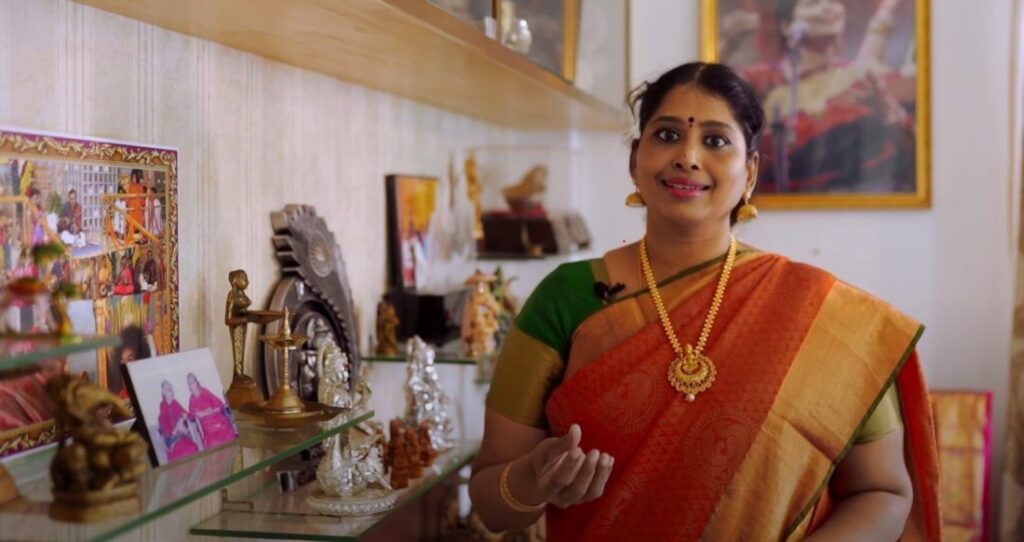Classical vocalist and playback singer Nithyasree Mahadevan shares experiences from her formative years as a grandchild of Carnatic musician DK Pattammal and mridangam maestro Palakkad Mani Iyer. The Chennaiite also reveals her acquired artistic vision.
What are your childhood memories about DK Pattammal (1919-2009) as paternal grandmother?
I grew up with Pattammal paati. Like any other grandmother, she used to play with us, tell us bedtime stories and look after us. I was following her like a shadow, watching her at home, playing with her.
Soon, as a musician, she influenced me a lot. She was guru for me as well as my mother Lalitha Sivakumar. When I was about four years old, she would take me to concerts. As a child, it used to be thrilling to go along with her, wearing a pattu pavadai, sitting next to her on the stage. She would discipline me, saying “no talking”, “sit properly” and so on. My sister, six years older, used to play the tambura.
Rasikas treated my grandma like goddess Saraswati. They would surround her and fall on her feet after concerts. It amazed and elated me as her granddaughter.
Her influence in you as a musician?
Only after I started singing did I understand her greatness as a musician. I learned music from my paati and my mother Lalitha (daughter of mridangam legend Palakkad Mani Iyer). My mother, while teaching, used to say: “Don’t think it is easy to reach the stature of Pattammalma. Her tireless efforts and sacrifices helped her to reach that stage.” Even in the later years of her life, grandma practised every day without fail.
Pattammalma influenced me subconsciously and consciously — as a musician, as a grandmother and as a revolutionary woman.
As a child, how do you remember a day in Pattammal’s life?
She was a perfectionist. Even in her late sixties, she would get up at five in the morning and practise. We, children, will be sleeping at that time and could hear her practice religiously. It was a serene experience. I used to lie on her lap while she practised. She would practise for about two hours and then does her daily chores.
From 10 to 1 pm she will teach the students. When there are no concerts, the evening will be busy with visitors, students and practice. She was very much active, and this continued till she was 87 years. In the last three years, she slowed down.
She never entertained learning by looking at a book or paper. Nor did she allow learning from a recorder. She would say, “You have to listen from the guru and have to learn through your ears, not eyes.” Never once have I seen her lose temper while teaching, even when the student isn’t catching a phrase. She would keep repeating until he or she gets it right. If someone who is not a regular student comes and asks her “Maami can you teach me a song?”, she would agree. She had more than 400 students.
How was her relationship with musician-brother DK Jayaraman?
Theirs was a very unique sibling relationship. Her eyes would sparkle when she gets a phone call from Jayaramamama. They would speak for hours. Even if he was staying at Alwarpet, 10 minutes away from our Kotturpuram home in Chennai, they would speak for hours over the phone. She was his guru as well. It was a pleasure to see them practising together, complimenting each other. I was fortunate to watch it.
How did Pattammal prepare for a concert?
Meticulously. How much ever she practised, she was never satisfied. She would keep on polishing even the simple songs again and again.
When she practise songs like Theertha vilayattu pillai or Eppadi padinalo, I used to tell her “Ayyo, how many times have you sung this! What is this!”. She would smile and reply: “No, we will sing once more and see.” She would get every song into her system, and make the her own. She would even sing in her dream. It was so passionate about music, so committed.
When she was bedridden towards her end, we would sit by her side. And ask, “Oh, we forgot the anupallavi of Devibrova samayamite. What was it?” She would say “Lokajanani”. At this, we’d say “Pattamma is fine!”
How did Palghat Mani Iyer influence you?
I was blessed to have two towering figures of Carnatic music in the family. Artistically, there are many similarities between them. Both were committed towards music and won’t compromise on any aspect of it. Even after becoming celebrities, they never took things lightly. No attitude like “Ok, let us see it on stage”.
Taatha would plan everything ahead of a concert. He would ensure the pitch of the mridangam matched the vocalist’s. He would play according to that style. The stage was the temple for both of them.
As individuals, taatha and paati were different. For taatha, there was no difference between music and life. Layam was everything for him — the whole universe, as he said in a speech. Layam means timing. He researched a lot on how to better his instrument, and his contribution is unparalleled.
While taatha was fully immersed in layam and did not bother about any other aspects, paati found time to enjoy a bit of broader life as well. She enjoyed cricket matches on TV and had a child-like curiosity in other aspects of life. As a person, she was an embodiment of simplicity and love.
The interview was done in association with Neelakanta Sivan Cultural Academy, Chennai
Also read: Shobhana Rangachari: A Lesser-Known Carnatic Vocalist

